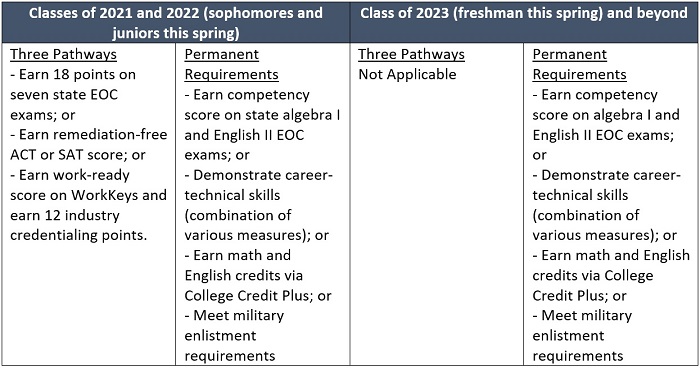On March 25, Ohio lawmakers unanimously passed emergency legislation that covers an array of policies affected by the coronavirus pandemic. In the realm of K–12 education, the bill (HB 197) allows high school principals (in consultation with teachers and counselors) to determine whether seniors in the class of 2020 who haven’t yet met state requirements may receive diplomas. It also exempts schools from administering state exams for the 2019–20 school year.
Authorizing school leaders to award diplomas was likely necessary for this year. Seniors still working to meet one of the graduation pathways—whether passing state exams, earning industry credentials, or several other alternatives—have had these options removed due to the closures. Yet as principals make decisions about graduation, they should remain mindful that non-college-going students—likely a large portion of those who haven’t yet met state requirements—will be entering a suddenly rough labor market. Though surely a difficult decision, withholding diplomas to less-than-ready students and encouraging them to repeat senior year might be a better option that having them face the prospect of unemployment.
While the immediate focus may be on the class of 2020, the state testing waivers create complications for future graduating classes. The table below displays the graduation requirements for the classes of 2021 to 2023. The “three pathways” refers to the “original” options that were first implemented starting with the class of 2018, while the “permanent requirements” refers to the recently enacted criteria that modified requirements after much debate. As the table indicates, the classes of 2021 and 2022 have the option of following either the three pathways or permanent requirements criteria to earn diplomas, while the permanent requirements begin full implementation with the class of 2023.
Table 1: Overview of graduation requirements for Ohio’s classes of 2021 through 2023

Note: The graduation requirements for the class of 2020 were different—they included several other alternatives (e.g., work hours and capstone projects)—than those for the classes of 2021 and beyond. Under longstanding state policy, students must also meet course-taking requirements, and under the permanent requirements pathway need to earn at least two “diploma seals.” For more details, see Ohio Department of Education, Overview of Graduation Requirements by Graduating Class.
Two things are important to know. First, in the coming years, most high school students will rely on passing the state end-of-course exams (EOCs) to meet graduation requirements.[1] The most critical for the classes of 2021 to 2023 are algebra I and English II, because students can achieve a competency score on them and meet a key graduation requirement. Second, the EOCs are designed to be taken right after students complete the course—much like an AP calculus exam is supposed to be taken after an AP calculus course.
The problem, then, is that a large number of Ohio’s freshmen, sophomores, and juniors (and some middle schoolers, too) are presently taking courses with corresponding EOC exams. If their schools don’t administer EOCs this spring, students will miss a chance to take the test with the material fresh in mind.
How to solve this conundrum? Like most things during this crisis, there’s no easy solution. But it’s worth going back to HB 197. Crucially, the legislation does not prohibit a school from administering state exams. Rather, it excuses schools from this requirement. Therefore, schools (should they be able to reopen safely) appear to have the discretion to administer EOCs when students physically return to school.[2]
In such case, Ohio schools should consider using their authority to administer the algebra I and English II exams, if not all of the EOCs, especially if they think students have made progress via remote learning. This would give students a much better shot at passing exams than if assessment waited until next year when many will have moved onto other courses. It would also enable schools to know sooner which students need help passing EOCs moving forward (retakes are allowed). At the very least, schools should offer EOCs to any student requesting to take an exam.[3]
Of course, it may not be safe to reopen schools before the school year ends. But even then, there are possibilities: Could schools open their doors over the summer to allow students to take EOCs in a specified window? Could they administer exams as soon as school restarts in the fall, or perhaps after some remediation? Could the Ohio Department of Education work with the EOC test developer to provide an at-home testing option without compromising the integrity of the assessment? (The College Board is working on this for AP exams.) Whatever the case may be, the state and local schools should strive to offer students the opportunity to take the EOCs as close to the completion of a course as possible.
In this extraordinary hour, legislators have temporarily suspended a number of policies that govern life during normal times. Now—more than ever—state and local leaders need to exercise their powers to act in the best interests of students.
[1] There are currently seven EOCs: English I and II; algebra I and geometry (or integrated math I and II); U.S. history, U.S. government, and biology. Starting with the class of 2023, the geometry and English I EOCs will be eliminated.
[2] The state superintendent may need to waive provisions related to testing windows; HB 197 provides him with broad authority to waive or extend deadlines during the health crisis.
[3] HB 197 cancels school report cards for 2019–20, so schools would not be held accountable for the test results.


